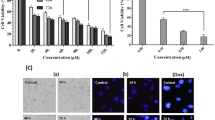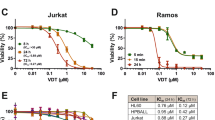Abstract
The antiproliferative effect of roxithromycin (RXM) was studied using human myeloid leukemia HL60 cells. RXM inhibited the growth of HL60 cells in a concentration-dependent manner, and significantly inhibited growth at concentrations above 75 μM. This growth inhibition was not associated with specific cell cycle arrest and DNA synthesis was not impaired. In addition, the number of viable cells remained almost unchanged in the presence of 100 νM RXM. RXM induced growth inhibition at least partly by the formation of multinucleate cells. Both flowcytometric and morphological examination revealed that more than 40% of the RXM-treated cells were binucleate. These findings demonstrate that RXM is a potent new modulator of cell cycle progression in HL60 cells and suggest that the inhibition of cytokinesis by this drug may provide a new model for studying mitosis.
Similar content being viewed by others
References
Roche Y, Gougerot-Pocidalo MA, Fay M, Forest N, Pocidalo JJ: Macrolides and immunity: effects of erythromycin and spiramycin on human mononuclear cell proliferation. J Antimicro Chemo 17: 195–203, 1986
Anderson R: Erythromycin and roxithromycin potentiate human neutrophil locomotionin vitro by inhibition of leukoattractantactivated superoxide generation and autooxidation. J Infect Dis 159: 966–973, 1989
Kita E, Sawaki M, Mikasa K, Hamada K, Takeuchi S, Maeda K, Narita N: Alterations of host response by a long-term treatment of roxithromycin. J Antimicro Chemo 32: 285–294, 1993
Konno S, Adachi M, Asano K, Okamoto K, Takahashi T: Anti-allergic activity of roxithromycin: Inhibition of interleukin-5-production from mouse T lymphocytes. Life Sciences 52: 25–30, 1993
Konno S, Adachi M, Asano K, Kawazoe T, Okamoto K, Takahashi T: Influences of roxithromycin on cell-mediated immune responses. Life Sciences 51: 107–112, 1992
Konno S, Adachi M, Asano K, Okamoto K, Takahashi T: Inhibition of human T-lymphocyte activation by macrolide antibiotic, roxithromycin. Life Sciences 51: 231–236, 1992
Pardee AB: G1 events and regulation of cell proliferation. Science 246: 603–608, 1989
Horiguchi-Yamada J, Yamada H: Differing responses of G2-related genes during differentiation of HL60 cells induced by TPA or DMSO. Mol Cell Biochem 119: 29–34, 1993
Horiguchi-Yamada J, Yamada H, Nakada S, Ochi K, Nemoto T: Changes of G1 cyclins, cdk2, and cyclin A during the differentiation of HL60 cells induced by TPA. Mol Cell Biochem 132: 31–37, 1994
Yamada H, Ochi K, Nakada, K, Nemoto T, Horiguchi-Yamada J: Changes of cell cycle-regulating genes in Interferon-treated Daudi cells. Mol Cell Biochem 136: 117–123, 1994
Yoshida M, Beppu T: Reversible arrest of proliferation of Rat 3Y1 fibroblasts in both the G1 and G2 phases by trichostatin A. Exp Cell Research 177: 122–131, 1988
Yoshida M, Nishikawa M, Nishi K, Abe K, Horinouchi S Beppu T: Effects of leptomycin B on the cell cycle of fibroblasts and fision yeast cells. Exp Cell Research 187: 150–156, 1990
Abe K, Yoshida M, Usui T, Horinouchi S, Beppu T: Highly synchronous culture of fibroblasts from G2 block caused by staurosporine, a potent inhibitor of protein kinases. Exp Cell Research 192: 122–127, 1991
Schroeder TE: The contractile ring. II. Determining its brief existence, volumetric changes, and vital role in cleavingArbacia eggs. J Cell Biol 53: 419–434, 1972
Hamaguchi Y, Mabuchi I: Effect of phalloidin microinjection and localization of fluorescein-labeled phalloidin in living sand dollar eggs. Cell Motility 2: 103–113, 1982
Mabuchi I, Takano-Ohmuro H: Effects of inhibitors of myosin light chain kinase and other protein kinases on the first cell division of sea urchin eggs. Dev Growth Differ 32: 549–556, 1990
Rubin EJ, Gill M, Boquet P, Popoff MR: Functional modification of a 21-kilodalton G protein when ADP-ribosylated by exoenzyme C3 ofClostridium botulinum. Mol Cell Biol 8: 418–426, 1988
Horiguchi Y, Sugimoto N, Matsuda M: Stimulation of DNA synthesis in osteoblast-like MC3T3-E1 cells byBordetella bronchiseptica dermonecrotic toxin. Infection and Immunity 61: 3611–3615, 1993
Mosmann T: Rapid colorimetric assay for cellular growth and survival: Application to proliferation and cytotoxicity assay. J Immunol Methods 65: 55–63, 1983
Nurse P: Universal control mechanism regulating onset of M-phase. Nature 344: 503–508, 1990
Norbury C, Nurse P: Animal cell cycles and their control. Annu Rev Biochem 61: 441–470, 1992
Murray AW: Creative blocks: cell-cycle checkpoints and feedback controls. Nature 359: 599–604, 1992
Millar JB, Russell P: The cdc25 M-phase inducer: An unconventional protein phosphatase. Cell 68: 407–410, 1992
Peter M, Nakagawa J, Dorée M, Labbé JC, Nigg EA:In vitro disassembly of the nuclear lamina and M phase-specific phosphorylation of lamins by cdc2 kinase. Cell 61: 591–602, 1990
Heald R, McKeon F: Mutations of phosphorylation sites in lamin A that prevent nuclear lamina disassembly in mitosis. Cell 61: 579–589, 1990
Ward GE, Kirschner MW: Identification of cell cycle-regulated phosphorylation sites on nuclear lamin C. Cell 61: 561–577, 1990
Liao H, Li G, Yen TJ: Mitotic regulation of microtubule cross-linking activity of CENP-E kinetochore protein. Science 265: 394–398, 1994
Yeo J, Alderuccio F, Toh B: A new chromosomal protein essential for mitotic spindle assembly. Nature 367: 288–291, 1994
Inagaki M, Nishi Y, Nishizawa K, Matsuyama M, Sato C: Site-specific phosphorylation induces disassembly of vimentin filamentsin vitro. Nature 328: 649–652, 1987
Matsuoka Y, Nishizawa K, Yano T, Shibata M, Ando S, Takahashi T, Inagaki M: Two different protein kinases act on a different time schedule as glial filament kinases during mitosis. EMBO J 11: 2895–2902, 1992
Chou Y, Bischoff JB, Beach D, Goldman RD: Intermediate filament reorganization during mitosis is mediated by p34dc2 phosphorylation of vimentin. Cell 62: 1063–1071, 1990
Kusubata M, Tokui T, Matsuoka Y, Okumura E, Tachibana K, Hisanaga S, Kishimoto T, Yasuda H, Kamijo M, Ohba Y, Tsujimura, K, Yatani R, Inagaki M: p13suc1 suppresses the catalytic function of p34dc2 kinase for intermediate filament proteins,in vitro. J Biol Chem 267, 20937–20942, 1992
Takeyama K, Tamaoki J, Chiyotani A, Tagaya E, Konno K: Effect of macrolide antibiotics on ciliary motility in rabbit airway epitheliumin vitro. J Pharma Pharmacol 45: 756–758, 1993
Author information
Authors and Affiliations
Rights and permissions
About this article
Cite this article
Nagai, M., Yamada, H., Nakada, S. et al. A macrolide antibiotic, roxithromycin, inhibits the growth of human myeloid leukemia HL60 cells by producing multinucleate cells. Mol Cell Biochem 144, 191–195 (1995). https://doi.org/10.1007/BF00944399
Received:
Accepted:
Issue Date:
DOI: https://doi.org/10.1007/BF00944399




